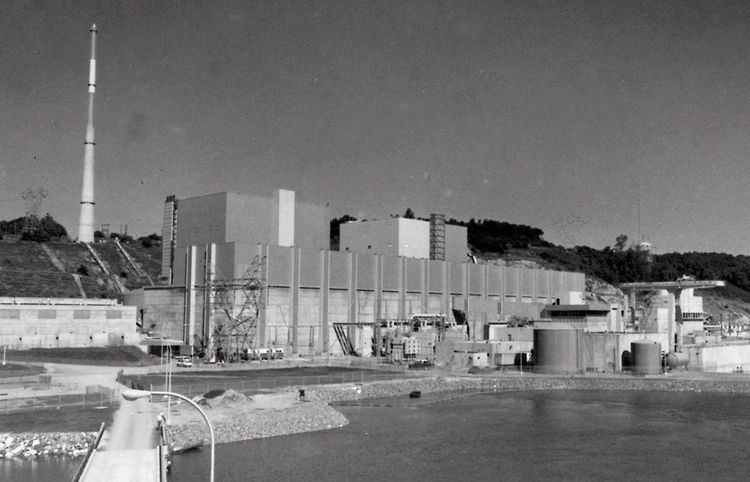Country United States Status Operational Phone +1 717-456-7014 | Location Peach Bottom, Penn. Decommission date 1974 (Unit 1) | |
 | ||
Reactor type BWR/4 MK I (Units 2 & 3) Address 1848 Lay Rd, Delta, PA 17314, USA Similar Limerick Generating Station, LaSalle County Nuclear, Susquehanna Steam Electric St, Beaver Valley Nuclear, Dresden Generating Station | ||
Peach Bottom Atomic Power Station, a nuclear power plant, is located 50 miles (80 km) southeast of Harrisburg in Peach Bottom Township, York County, Pennsylvania, on the Susquehanna River three miles north of the Maryland border.
Contents
The Philadelphia Electric Company (later shortened first to PECO Energy and later to just PECO) became one of the pioneers in the commercial nuclear industry when it ordered Peach Bottom 1 in 1958. The U.S.'s first nuclear power plant (the Shippingport Reactor) had gone on line a year earlier. Peach Bottom Unit 1 was an experimental helium-cooled, graphite-moderated reactor. It operated from 1966 to 1974. The other two units, General Electric boiling water reactors, placed on-line in 1974, are still in operation on the 620-acre (2.5 km2) site. Both Units 2 and 3, originally rated at 3,514 megawatts thermal (MWth), equivalent to about 1,180 megawatts of electricity (MWe) each, were uprated to 3,951 megawatts thermal (MWth), equivalent to about 1,308 megawatts net of electricity (MWe) each in 2014. Their licenses run until 2033 (Unit 2) and 2034 (Unit 3).
Peach Bottom is operated by the Exelon and is jointly owned by Exelon (50%) and Public Service Enterprise Group (PSEG) Power LLC (50%).
Peach Bottom was one of the plants analyzed in the NUREG-1150 safety analysis study.
Surrounding population
The Nuclear Regulatory Commission defines two emergency planning zones around nuclear power plants: a plume exposure pathway zone with a radius of 10 miles (16 km), concerned primarily with exposure to, and inhalation of, airborne radioactive contamination, and an ingestion pathway zone of about 50 miles (80 km), concerned primarily with ingestion of food and liquid contaminated by radioactivity.
The 2010 U.S. population within 10 miles (16 km) of Peach Bottom was 46,536, an increase of 7.2 percent in a decade, according to an analysis of U.S. Census data for msnbc.com. The 2010 U.S. population within 50 miles (80 km) was 5,526,343, an increase of 10.6 percent since 2000. Cities within 50 miles include Baltimore (36 miles to city center).
Safety concerns
In 1987, PECO was ordered by the Nuclear Regulatory Commission (NRC) to indefinitely shutdown Peach Bottom-2 and -3 on March 31 due to operator misconduct, corporate malfeasance and blatant disregard for the health and safety of the area. Infamously, operators were found sleeping on the job, playing video games, engaging in rubber band and paper ball fights, and reading unauthorized material.
Among the incidents cited by the NRC: security guards were overworked, one guard was found asleep on the job, 36,000 gallons of "mildly radioactive water" leaked into the Susquehanna River, PECO mislaid data on radioactive waste classification causing misclassification of a waste shipment, and a major fire occurred in the maintenance cage of the Unit 3 turbine building on March 4, 1987.
Blame was not simply placed on the operators. “Latent organizational weakness” was targeted by industry experts and regulators alike. INPO President Zack Pate came to the conclusion that “Major changes in the corporate culture at PECO are required.” In September 1988, NRC Chairman Lando Zech told senior management officials of PECO, "Your operators certainly made mistakes, no question about that. Your corporate management problems are just as serious." Clearly, a culture characterized by low morale and apathy prevailed. By April 1988, this emphasis on mismanagement contributed to the President of PECO resigning as well as to the retirement of the CEO.
Robert P. Crosby became the primary Organization Development influence during the PECO Nuclear turnaround following the Peach Bottom shut down. He used The Interpersonal Gap model by John L. Wallen along with a unique T-group method known as Conflict Management (and later as Tough Stuff in other business applications) to speed culture change, and applied his own version of Daryl Conner's Sponsor Agent Target model to improving and shortening outage management.
By 1996, both Limerick and Peach Bottom were designated excellent by INPO, and given strong Systematic Assessment of Licensee Performance (SALP) ratings by the NRC.
In 1999, PECO Nuclear eliminated their Organization Development positions as part of cost cutting initiative.
Trouble arose again in September 2007, when former employee Kerry Beal videotaped Peach Bottom security guards sleeping on the job. Beal had previously tried to notify supervisors at Wackenhut Corp. and the US Nuclear Regulatory Commission. He was eventually fired during the Exelon security transition, a decision which made a list of the 101 "dumbest moments in business" in the January 16, 2008 issue of Fortune.
Seismic risk
The Nuclear Regulatory Commission's estimate of the risk each year of an earthquake intense enough to cause core damage to the reactor at Peach Bottom was 1 in 41,667; according to an NRC study published in August 2010.
